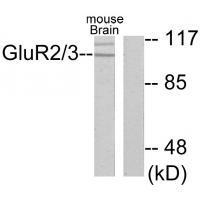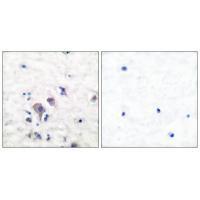

| WB | 咨询技术 | Human,Mouse,Rat |
| IF | 咨询技术 | Human,Mouse,Rat |
| IHC | 1/50-1/100 | Human,Mouse,Rat |
| ICC | 技术咨询 | Human,Mouse,Rat |
| FCM | 咨询技术 | Human,Mouse,Rat |
| Elisa | 咨询技术 | Human,Mouse,Rat |
| Aliases | GPRC1C; GRM3; MGR3; Metabotropic glutamate receptor 3 precursor; glutamate receptor metabotropic type 3 |
| Entrez GeneID | 2913; |
| WB Predicted band size | 96,99kDa |
| Host/Isotype | Rabbit IgG |
| Antibody Type | Primary antibody |
| Storage | Store at 4°C short term. Aliquot and store at -20°C long term. Avoid freeze/thaw cycles. |
| Species Reactivity | Human,Mouse,Rat |
| Immunogen | Synthesized peptide derived from human GluR2/3. |
| Formulation | Purified antibody in PBS with 0.05% sodium azide. |
+ +
以下是3篇关于GluR2/3抗体的代表性文献摘要(文献名称、作者及核心内容):
---
1. **文献名称**: *Selective reduction of GluR2 protein in adult hippocampal CA1 neurons following status epilepticus but prior to cell death*
**作者**: Friedman LK, et al.
**摘要**: 该研究通过免疫组织化学和Western blot发现,癫痫持续状态后,海马CA1区GluR2/3蛋白水平显著下降,且这种减少先于神经元死亡出现,提示GluR2缺失可能通过增强钙内流加剧兴奋性毒性。
---
2. **文献名称**: *AMPA receptor GluR2/3 subunit–specific antibody immunoreactivity in the human Huntington's disease brain*
**作者**: Durens M, et al.
**摘要**: 使用GluR2/3特异性抗体对亨廷顿病患者脑组织分析发现,纹状体和皮层中GluR2/3亚基表达显著降低,表明AMPA受体亚基异常可能与疾病进展中的突触功能障碍相关。
---
3. **文献名称**: *Characterization of monoclonal antibodies to glutamate receptor 3 (GluR3)*
**作者**: Twyman RE, et al.
**摘要**: 本研究开发并验证了针对GluR3亚基的单克隆抗体,证实其特异性识别天然和重组GluR3蛋白,适用于免疫沉淀及脑切片染色,为研究AMPA受体亚细胞分布提供了工具。
---
**备注**:如需具体期刊信息或DOI,建议通过PubMed/Google Scholar搜索作者名+关键词获取原文。部分经典研究可能集中在1990s-2000s年代。
GluR2/3 antibodies are immunological tools targeting specific subunits of the AMPA-type glutamate receptors, which mediate fast excitatory synaptic transmission in the central nervous system. AMPA receptors are tetrameric ion channels composed of subunits GluR1-4 (GluA1-4), with GluR2 (GluA2) and GluR3 (GluA3) being critical for regulating receptor properties. A key feature of GluR2 is its RNA-edited Q/R site, which renders AMPA receptors impermeable to calcium ions and influences synaptic plasticity, neuronal excitability, and vulnerability to excitotoxicity. Antibodies recognizing both GluR2 and GluR3 subunits are widely used to study their expression, localization, and functional roles in physiological and pathological contexts.
These antibodies are employed in techniques like immunohistochemistry, Western blotting, and immunoprecipitation to investigate AMPA receptor distribution in brain regions, synaptic changes during learning or disease, and alterations in conditions such as epilepsy, stroke, or neurodegenerative disorders. Since GluR2 and GluR3 often co-assemble in native receptors, dual-specificity antibodies provide insights into receptor composition while distinguishing them from GluR1- or GluR4-containing complexes. However, their cross-reactivity requires validation using knockout controls or subunit-specific assays. Research using GluR2/3 antibodies has highlighted their roles in synaptic scaling, ischemia-induced neuronal damage, and psychiatric disorders, underscoring AMPA receptor diversity as a therapeutic target. Proper application of these antibodies contributes to understanding excitatory signaling mechanisms and their dysregulation in neurological diseases.
×